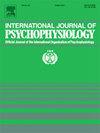Insufficiently active individuals' electrocortical and self-reported responses to images of exercise of different types and settings
IF 2.5
3区 心理学
Q3 NEUROSCIENCES
引用次数: 0
Abstract
Most people are insufficiently physically active, and their automatic affective valuations of exercise may be a culprit. Physical activity campaigns use exercise images to encourage physical activity, but whether some types of images elicit more positive automatic affective valuations is unclear. Our study investigated whether the type (sport vs. gym) and setting (indoors vs. outdoors) of exercise images influence insufficiently active individuals' automatic affective valuations of them. Specifically, we recorded electroencephalography from insufficiently active participants while they completed an oddball task wherein exercise images of different settings and types were embedded among positive, neutral, and negative non-exercise images. We extracted the P3b event-related potential component elicited by the exercise images to measure automatic affective valuations of the images. We also recorded participants' self-reported evaluations of the images to measure explicit affective responses. The results of a mixed-effects model indicated that P3b amplitude was larger for outdoors and gym exercise images than indoors and sport exercise images, respectively, but these effects did not depend on whether the images were embedded among positive, neutral, or negative non-exercise images. This suggests the setting and type of exercise images influenced the degree to which they were cognitively processed but not their automatic affective valuation. We also found exercise images were explicitly perceived as neutral-to-positive and their setting and type did not affect this explicit affective evaluation. In summary, for insufficiently active individuals, the setting and type of exercise images were found to influence their cognitive processing but not their automatic or explicit affective evaluation.
不充分活动个体对不同类型和设置的运动图像的电皮层和自我报告反应
大多数人身体活动不足,他们对运动的自动情感评价可能是罪魁祸首。体育活动活动使用运动图像来鼓励体育活动,但是否某些类型的图像会引发更积极的自动情感评价尚不清楚。本研究探讨运动图像的类型(运动与健身房)和环境(室内与室外)是否会影响运动不足个体对运动图像的自动情感评价。具体来说,我们记录了活动不足的参与者在完成一项奇怪任务时的脑电图,其中不同设置和类型的运动图像嵌入在积极、中性和消极的非运动图像中。我们提取运动图像引发的P3b事件相关电位分量来测量图像的自动情感估值。我们还记录了参与者对图像的自我评价,以测量显式情感反应。混合效应模型的结果表明,户外和健身房运动图像的P3b振幅分别大于室内和体育运动图像,但这些影响并不取决于图像是否嵌入在积极、中性或消极的非运动图像中。这表明运动图像的设置和类型影响了他们的认知加工程度,但不影响他们的自动情感评价。我们还发现,运动图像被明确地认为是中性到积极的,它们的设置和类型并不影响这种明确的情感评价。总之,对于运动不足的个体,运动图像的设置和类型会影响他们的认知加工,但不会影响他们的自动或外显情感评估。
本文章由计算机程序翻译,如有差异,请以英文原文为准。
求助全文
约1分钟内获得全文
求助全文
来源期刊
CiteScore
5.40
自引率
10.00%
发文量
177
审稿时长
3-8 weeks
期刊介绍:
The International Journal of Psychophysiology is the official journal of the International Organization of Psychophysiology, and provides a respected forum for the publication of high quality original contributions on all aspects of psychophysiology. The journal is interdisciplinary and aims to integrate the neurosciences and behavioral sciences. Empirical, theoretical, and review articles are encouraged in the following areas:
• Cerebral psychophysiology: including functional brain mapping and neuroimaging with Event-Related Potentials (ERPs), Positron Emission Tomography (PET), Functional Magnetic Resonance Imaging (fMRI) and Electroencephalographic studies.
• Autonomic functions: including bilateral electrodermal activity, pupillometry and blood volume changes.
• Cardiovascular Psychophysiology:including studies of blood pressure, cardiac functioning and respiration.
• Somatic psychophysiology: including muscle activity, eye movements and eye blinks.

 求助内容:
求助内容: 应助结果提醒方式:
应助结果提醒方式:


